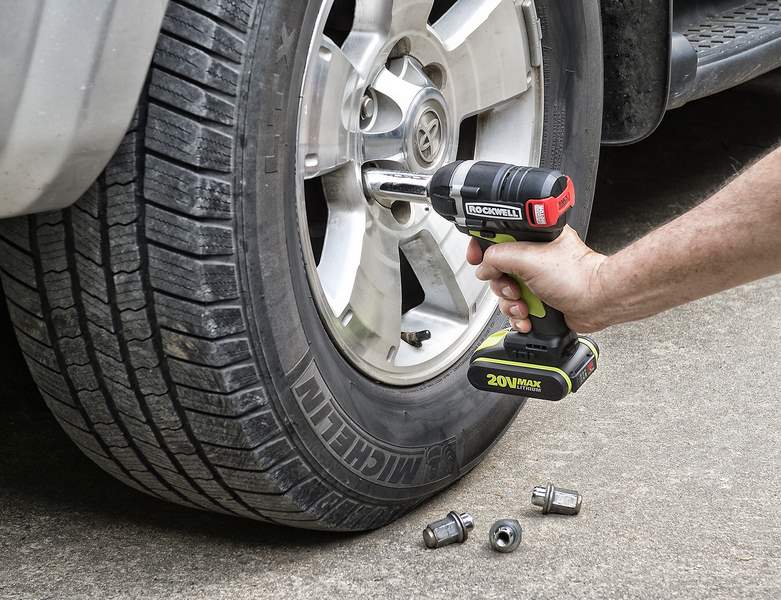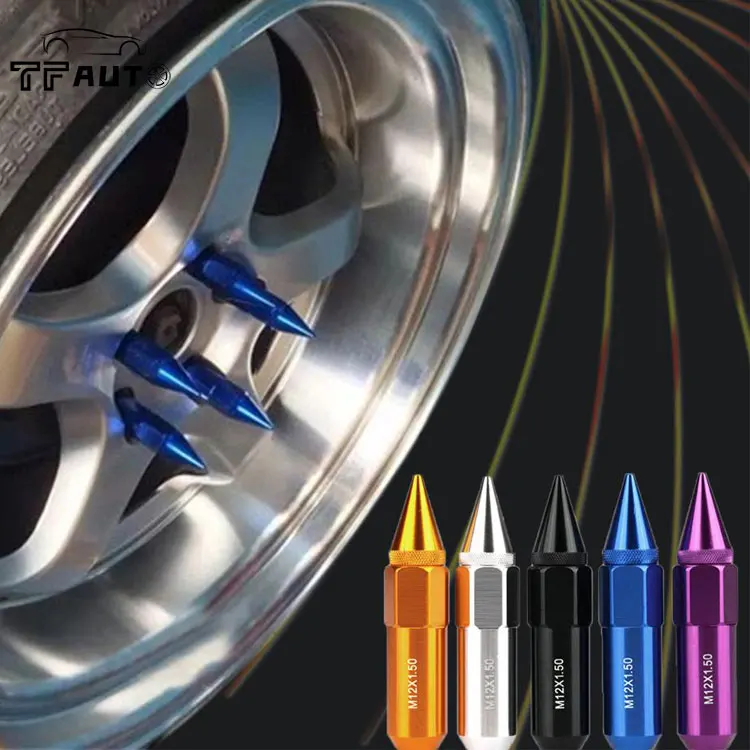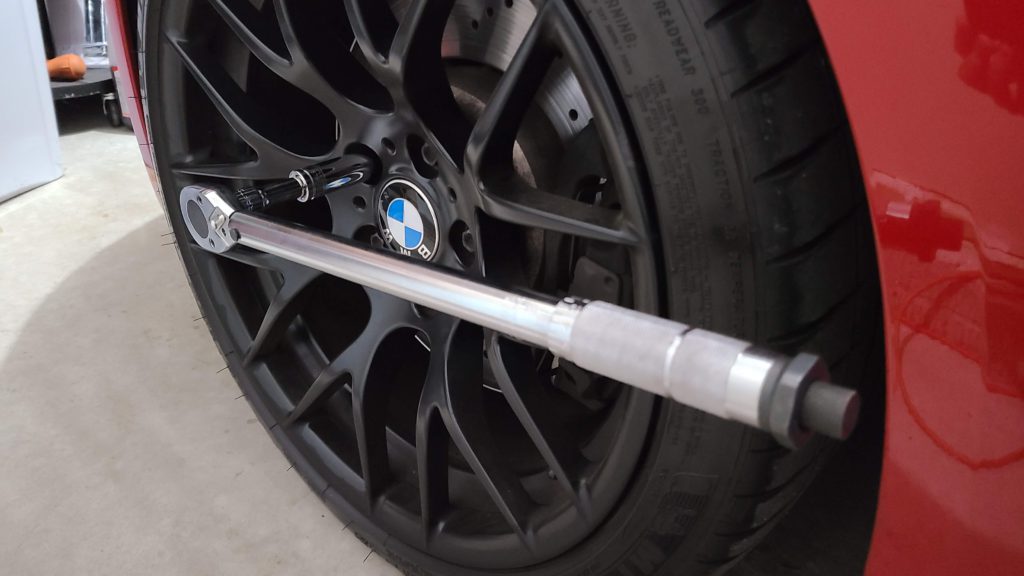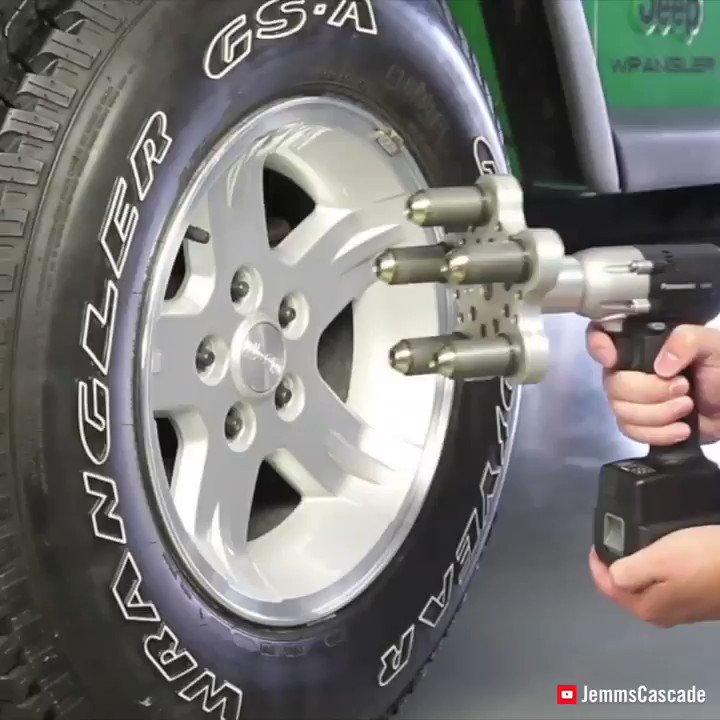1A Auto Team 1A Auto Blog Home
A stripped lug nut can be one of the most frustrating problems you will come across while doing vehicle repairs. Most of the time, lug nuts become stuck when someone goes a bit too far while tightening. In this post and the video below we’ll show you 3 ways you can try to remove a stripped lug nut.
A typical lug nut has a cap. When torqued beyond the manufacturer’s specification, the cap separates from the lug nut and allows moisture to get in. This then causes the nut to rust and stick to the hub assembly.
If you ever find yourself stuck with a stripped lug nut that won’t come off, you’ll need to have an extra set of tools nearby. We’ll take a look at some of the most effective ways you can easily remove a stripped lug nut that’s stuck to the wheel.
Normally a stuck lug nut will have smaller corners, and this makes it hard to remove it using the original-sized socket. You may need a smaller socket to provide the grip needed. If you experience difficulty lining the socket, use a hammer to tap on it until it fits.
Once the socket is lined up, connect a breaker bar and try to remove the nut. You can place a pipe at the end of the bar for extra leverage. If the lug nut is too stuck and won’t turn, don’t keep turning the bar to keep it from breaking.
If the lug nut is too stuck and won’t turn, don’t keep turning the bar to keep it from breaking.
If you try the breaker bar and socket method and still find that the lug nut won’t come off, get your hands on a powerful impact wrench. Impact wrenches are designed to tighten or loosen various nuts, bolts, and screws, and use torque and short jolting blows to deliver the necessary power needed to loosen a lug nut.
The most powerful variants deliver up to 250 foot-pounds of torque or more. This is enough muscle to bust a rusty and stuck lug nut. If your impact wrench doesn’t get the job done, try a drill.
A drill bit is a much safer tool to use when removing a stripped lug nut compared to an air hammer, an air chisel, or a torch, which can cause serious damage to the wheel easily if handled the wrong way.
When using your drill, start with smaller-sized drill bits and work your way up. Aim for the center of the lug nut. You can start by making an indentation at the center using a center punch to prevent the drill bit from slipping. You could also use a burr attachment with a die grinder.
You can start by making an indentation at the center using a center punch to prevent the drill bit from slipping. You could also use a burr attachment with a die grinder.
Drilling can often be a long and tedious process. For safety purposes and to prevent the drill bit from dulling, have a cup of oil nearby. Dip the drill bit every once in a while into the oil to cool it down before drilling any further.
As you move from the smaller-sized drill bit to the larger ones, keep checking to confirm that you’re still aiming for the center of the lug nut. You can use a parts cleaner to remove the chips that may be filling the hole as you do the job. If by any chance you happen to drill off-center, use the burr tool with the die grinder to correct the hole.
After a decent amount of drilling, the wheel should slide out easily. You may find the lug nut remains stuck to the wheel sometimes. You can remove it using a pair of channel lock pliers, a torch, or an air hammer.
 com
com Remember to shop for new lug nuts at 1A Auto when replacing your wheel. If you penetrated the other side of the lug nut while drilling, you may need to replace the wheel stud as well in the case it’s damaged.
Summary
It’s not uncommon to find a stripped or stuck lug nut when attempting to remove a wheel from the car. However, you must know how to remove a stuck or stripped lug nut or you are in trouble. There are multiple methods you can choose from, depending on the situation you face.
However, you must know how to remove a stuck or stripped lug nut or you are in trouble. There are multiple methods you can choose from, depending on the situation you face.
In this guide, we discuss your options to remove the stuck lug nut. We also cover the reasons why the lug nut is stripped and lay out some simple tips to help prevent this problem from occurring in the first place.
How Do Lug Nuts Get Stripped? 1. Corrosion and rustThe wheel’s lug nuts are made from metal. When these are exposed to the elements and moisture, corrosion and rust can occur.
After corrosion sets in, the lug nut threads deform. As the shape changes, it becomes more difficult to take them off.
2. Using Wrong SocketTo remove the lug nut properly, you must have the right size socket. If you don’t, there will be slippage as you try to take it off.
When the socket slips, it leads to further damage. Even if you get it off this time, you are making it more difficult next time. If you use a very old and worn or low-quality socket, it may be worth trying a new high-quality socket instead. This will also prevent further issues in the future.
If you use a very old and worn or low-quality socket, it may be worth trying a new high-quality socket instead. This will also prevent further issues in the future.
Every lug nut is meant to be tightened to the factory-set specification. You can find this torque measurement in the service manual.
If you tighten the lug nut with the incorrect amount of torque, you can get it stuck. For this reason alone, you don’t want to visit a shady tire shop.
How to Remove a Stuck or Stripped Lug NutThe most common method is to use an extractor socket and hammer with the help of a breaker bar. A blowtorch can also be helpful. If those methods fail, consider using a handheld grinder with a wrench. There’s also the option to use a screwdriver, hammer and chisel.
Here’re some more details about these options of how to remove a stuck or stripped lug nut:
1. Extractor Socket/Hammer/Breaker BarThis is the best method that will work probably 99% of the time. Most of the tools you need for this job can be found in your home garage. You will require a breaker bar, penetrating oil, hammer, and a nut extractor socket. Make sure your vehicle is parked on a flat surface. You can use wheel chocks and the emergency brake as further safety precautions.
Most of the tools you need for this job can be found in your home garage. You will require a breaker bar, penetrating oil, hammer, and a nut extractor socket. Make sure your vehicle is parked on a flat surface. You can use wheel chocks and the emergency brake as further safety precautions.
Soak the rounded lug nut in some penetrating oil. If there’s rust, you want to cover it liberally. You can also use the hammer to break the rust away.
You also want to use a long socket on the stuck lug nut first, then hit it a couple of times with a large hammer. This will loosen the tightness of the cone, and it will be much easier to loosen it. However, it may be too stripped to remove completely with a regular socket. At the very least, it’s worth a try.
(Watch your fingers and rims though! I learned that tip from experience. Trust me, you don’t want to make the same mistake.)
Then, after a couple of hits, remove the socket and put on a nut extractor socket that’s sized properly. You can use a hammer to bang on the socket until you get it tight, with a good grip.
You can use a hammer to bang on the socket until you get it tight, with a good grip.
With your breaker bar attached to the socket, apply force to the handle. You want to move it counter-clockwise to take off the stripped nut. If it’s too tight, you want to extend the breaker bar handle with an iron pipe or use a strong impact wrench instead.
RELATED: How to Remove a Stuck Wheel on Your Car (5 Easy Steps)
2. BlowtorchThese steps are often faster, but not everyone has a blowtorch on hand. If you do, you will also need a wheel spanner or pliers to grab the lug nut while it is hot. Additionally, you don’t want to use any oil with this method. Otherwise, you could create a fire with the heat involved.
Take your blowtorch and heat the nut. Do this slowly – you need to be cautious. Once it is heated up, let it cool down. Do these steps a couple of times until the nut breaks loose. As it heats, the wheel nut size expands, making it easier to get the nut off. However, this method can damage the paint on your rims, so the other methods are preferred.
However, this method can damage the paint on your rims, so the other methods are preferred.
Again, you will need to use some penetrating oil with these steps. Remember to let it soak and try to remove some of the rust, if possible.
With your handheld grinder, make edges around the nut. You want to be able to grab onto it with your wrench. Once you can grab it securely, turn it until you get it loose. It can be difficult to reach the lug nuts with a grinder if you have aluminum rims, so in this case, you may want to try the other methods first.
4. Screwdriver/Hammer/ChiselIf all else fails, you always have this option. It wouldn’t be the first that we would try, but if you’ve run out of other ideas, it doesn’t hurt to throw everything you have at it.
Along with your screwdriver, hammer and chisel, grab some penetrating oil to make it easier. Apply the oil to the nut and let it sit. You want it to remove the rust and corrosion.
With your chisel, you can push the screwdriver down into the nut. A notch will be made in the surface. Take your screwdriver and wedge it into the notch that was created. Take your hammer and tap the screwdriver, causing it to move counter-clockwise. You will continue these steps until you break the nut loose.
If you don’t have the right tools for this or tried everything above, it may be time to visit a professional mechanic that does this stuff often!
RELATED: 10 Best Rust Converters – Review & Buyer’s Guide
How to Remove Lug Nut When Stud is StrippedIf the lug nut is spinning freely but you can’t get it off of the stud, you are dealing with a stripped stud instead. This issue can be just as much of a pain to deal with. However, you only need a drill bit that pairs with the same size as the stud.
Drill at a low speed, but apply heavy pressure on the center of the lug nut. Do this until it isn’t attached to the wheel stud any longer.
Just keep in mind that you must replace the wheel stud once you drill through it. Be prepared for the time this takes and the cost before you get started.
RELATED: Wheel Nut Cross Threaded – What to Do & How to Prevent it?
How To Avoid Stripped Lug NutsIt’s far better to avoid getting the lug nuts stuck than to try and get them off. With the proper prevention methods, you won’t have to walk through the above steps again.
For starters, you don’t want to visit a shady tire shop. If the technicians don’t know what they are doing, they will strip the lug nut, leaving you with a problem on your hands. Instead, you should visit a well-known shop that has good reviews. After your lug nuts are reinstalled, you should check them to ensure they can come off. If not, it’s best to take the issue up with the tire shop immediately.
If you decide to work on the wheels yourself, avoid over-torquing the nut. You can find the right specs listed in your service manual. If you don’t have the right tools for the job, you need to either get them or take your car in for professional service instead.
If you don’t have the right tools for the job, you need to either get them or take your car in for professional service instead.
It’s also important to keep the lug nuts clean and free of corrosion. If water and dirt are allowed to sit on the wheels, the nut will corrode. Wash and dry the wheels frequently to avoid this condition.
Can WD-40 Be Used to Remove Stuck Lug Nuts?There’s a common saying that WD-40 can be applied to anything that’s not moving that should be. With this in mind, WD-40 is a great option when dealing with stuck or stripped lug nuts.
As with any penetrating oil, you can spray the WD-40 directly on the threads and allow it to soak. The longer it sits on, the easier your job will be. This spray is going to help loosen up the nut for easier removal. After you apply the solution, tap on the lug with a hammer. This simple action allows the spray to be pushed around, causing it to further penetrate the area for easier removal.
This spray is going to help loosen up the nut for easier removal. After you apply the solution, tap on the lug with a hammer. This simple action allows the spray to be pushed around, causing it to further penetrate the area for easier removal.
Categories: Tires, Guides
Sooner or later, any owner is faced with a situation where a nut, bolt or self-tapping screw does not want to get out. There are several reasons for this: poor quality metal, violation of technology (overheated self-tapping screws), rust, time, too much effort applied when tightening the connection. Nevertheless, it is possible to unscrew a bolt with torn edges, a licked nut, a rusted connection. In this article, we'll talk about how to do it.
"Licked" edges on bolt heads or nuts are not uncommon. Excessive forces that are applied when tightening, and then when loosening, often lead to the fact that the boundary between the faces of the bolt is erased. If the bolt does not unscrew - ordinary keys are powerless in this case - they simply scroll, and the fasteners remain in place.
If the bolt does not unscrew - ordinary keys are powerless in this case - they simply scroll, and the fasteners remain in place.
There are several ways to unscrew shear bolts and nuts:
If there is a plastic or rubber gasket under the bolt, remove it and try one of the suggested methods again. If you cannot unscrew the bolt with torn edges in all these ways, there is only one thing left: cut / cut off the hat and drill out the pin.
Another problem that is familiar to car enthusiasts (and not only) is a rusted nut and / or thread. In this case, you should not make heroic efforts to unscrew the fasteners. Your faces will simply “merge” and another problem will be added to the boiled thread. If after a couple of attempts, you can’t unscrew it, try the following methods one by one:
If after a couple of attempts, you can’t unscrew it, try the following methods one by one:
Rust can also be treated with grease. Try filling the joint with fluid multipurpose grease (available in WD40 cans). After waiting a couple of hours, we try to work with the key. Didn't work - try other ways one by one.
If the hardened self-tapping screws are unscrewed / twisted a couple of times, their edges lose their sharpness, the screwdriver scrolls, and the screw itself remains in place. If he "sits" in wood, plaster, chipboard or other similar, not too hard materials, you can put a thin elastic band under the screwdriver (for example, for hair). Due to the force of elasticity, they achieve a tighter fit to the remaining faces, which helps to move the self-tapping screw from its place. Other methods are more "traumatic":
The remains of a bolt or stud without a head can be unscrewed as follows: cut a left-hand thread in the remaining body, drip glue "torque", screw in the left tap, leave for an hour. Apply oil to the main thread and leave for an hour as well. When the glue sets, twist it out. If the remains of a self-tapping screw are stuck in the wood, it is easier to close this hole and install other fasteners nearby.
Apply oil to the main thread and leave for an hour as well. When the glue sets, twist it out. If the remains of a self-tapping screw are stuck in the wood, it is easier to close this hole and install other fasteners nearby.
The problem of stuck fasteners is familiar to many motorists. Under the influence of moisture, bolts, nuts and screws rust, and it becomes very difficult to unscrew them. But no matter how “difficult” the bolt is, professional car mechanics know what to do, because they disassemble even the most problematic parts.
With a wrench, tap the stuck fasteners from all sides.
Any fastener that is covered in rust should first be cleaned with a wire brush and then tapped from different directions. This simple method often saves time and effort.
To unscrew the hub nut, you need to seriously “build up” the wrench. | Photo: drive2.ru.
Drivers who have ever repaired a car with their own hands know that the larger the bolt or nut to unscrew, the more force must be applied to the tool. And if the fasteners are rusty, then you have to sweat. To make it easier, they usually lengthen the handle of the key. To do this, use a pipe of a suitable diameter. This allows you to increase the torque while applying less force.
Theoretically, in this way it is possible to rip off any “difficult” nut or unscrew the bolt, if not for one “but”: with great effort, the head of the fastener can simply be licked off. It is better not to allow this, as the repair will become more complicated several times.
Stuck fasteners should be lubricated with a penetrating lubricant. | Photo: electro-shema.ru.
Rusty bolts and nuts, which have been sitting tightly in place for years, very often "grow" threads to the counterpart. In this case, a tool that will lubricate the thread is useful. The first thing that comes to mind is the famous WD-40. You can also use kerosene. But it is worth knowing that if "vedeha" does not help, then no "chemistry" will help.
In this case, a tool that will lubricate the thread is useful. The first thing that comes to mind is the famous WD-40. You can also use kerosene. But it is worth knowing that if "vedeha" does not help, then no "chemistry" will help.
Seized fasteners are heated with ordinary gas from a cylinder. | Photo: youtube.com.
If the previous methods did not help, then it's time to take on more effective measures. First of all, the stuck parts need to be heated; for this, a gas burner is used. If you unscrew the nut, then you need to heat it. And if it is a bolt, then the torch of flame is directed to the part into which it is screwed. With a large increase in temperature, the parts expand, which increases the gap in the thread.
In addition, thread lockers are often used in vehicle assembly. When heated, they become fluid, "lower" the bolt or nut, and then it is easier to unscrew them.
Sometimes the bolt cannot be removed without breaking it.